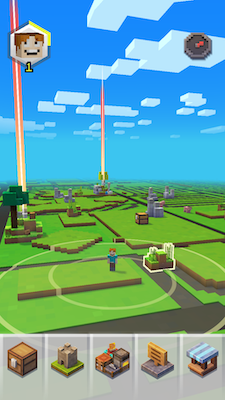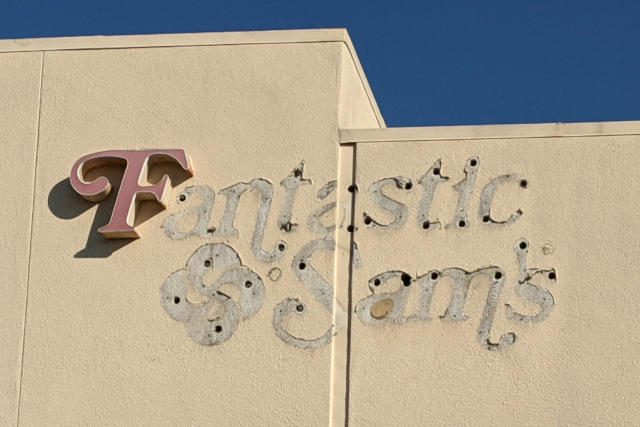I’ve got to appreciate this network error UI from Minecraft Earth. Especially the button text.

I’ve got to appreciate this network error UI from Minecraft Earth. Especially the button text.

Took Minecraft Earth for a spin around the block. Most of the demos I’d seen showed either the build-on-a-plate mode or the AR adventure mode, so I wasn’t sure how the map mode was going to work.
 You see a Minecraft-ified version of your local area. Real-world buildings appear as raised ground instead of buildings, so that you can see where they are, but there’s no risk of mismatches between real doors and virtual ones. Clusters of resources appear on the map: trees, boulders, mounds of dirt and such, along with sheep, cows and other mobs wandering around. You can tap on them repeatedly like you’re mining in the original game, and after a few seconds you get the mob, or the logs, stone blocks, dirt, flowers, etc.
You see a Minecraft-ified version of your local area. Real-world buildings appear as raised ground instead of buildings, so that you can see where they are, but there’s no risk of mismatches between real doors and virtual ones. Clusters of resources appear on the map: trees, boulders, mounds of dirt and such, along with sheep, cows and other mobs wandering around. You can tap on them repeatedly like you’re mining in the original game, and after a few seconds you get the mob, or the logs, stone blocks, dirt, flowers, etc.
You can use these resources to craft items with familiar recipes, but each item takes time (like smelting) instead of a shape. It might take 30 seconds to turn a log into planks, or three minutes to make a sword. There are three slots for the crafting table and three for the furnace, with one each unlocked at the beginning of gameplay. I’m guessing you unlock the others as you level up.
Resources seem to regenerate quickly – I saw them pop into existence a couple of times on my walk around the block, and there was already a new tree when I got back where I started.
You can also see a circle (I know, a circle! In Minecraft!) on the map showing what’s close enough to interact with, and whenever something crosses that circle, the phone will vibrate briefly to let you know.
A nice touch: If you’re moving faster than walking speed (or if it thinks you are due to GPS drift), it shows your avatar rolling in a mine cart!
Speaking of avatars, if you’ve used the new character creator in recent releases of Bedrock edition, that skin automatically transfers to this game.
Actually playing “adventures” is a bit weird. This is the gameplay they showed during Minecon. At certain spots, you can jump into an augmented-reality instance (the one I tried was roughly a 5 block by 5 block column) with items you’ve crafted or collected. You can fight zombies, find treasure chests, etc. It’s cool, but because you can’t physically move up or down, just around, it’s sort of like walking around a hole in the ground and trying to interact with stuff that’s way below you.
Anyway, I’ve spent longer writing about it than playing so far. I’ll have to take some time to really explore it and get a better sense of the gameplay. And try out the build plates.
But even at first glance, it’s a distinct experience compared to Pokemon Go, and not just a rehash with a different theme!
Update: A key difference I’ve noticed between Pokemon Go and a couple of short sessions in Minecraft Earth is that the world of Minecraft Earth is a lot denser than Pokemon Go.
With Pokemon Go, you have fixed locations for supplies and combat. It’s all about getting you out to walk that distance and find Pokemon along the way. There are even multiple rewards solely for distance walked (candy, hatching eggs, evolving certain Pokemon).
With Minecraft Earth, everything is randomly placed, closer together, and visible from farther away: resources, mobs, adventures. (And you can use a build plate anywhere.) It looks more like a Minecraft world than a map, and it feels like you could play it in a smaller space if you wanted to.
I saw an article about open space preservation efforts in Newport Beach, and decided to look up the area on maps’ satellite view. Looking around nearby areas in Newport, Laguna Beach, Irvine, Tustin, Orange, etc, I realized: the timeline of residential development in central Orange County is actually visible.
I don’t know how well it tracks for other areas. I’m less familiar with southern Orange County, for instance, and areas from Santa Ana northward into the LA Basin are much flatter and were largely built-up by the time I started paying attention.

Sign spotted near LAX.
Update: Replaced with a clearer photo. The original one was backlit during late afternoon.

It’s like someone started to take down the sign, got almost to the end, and said, “F this, I’m going home.”
Yahoo Groups is shutting down, taking years’ worth of users’ writing and discussions with it. It’s the latest reminder that if you don’t host it yourself, your stuff is at the mercy of someone else’s business decisions. Or whims.
And yet…
My old blog posts are full of dead links to sites where people were hosting their own stuff, but it’s gone now. I’m sure some was taken down deliberately, but I’m sure there’s also a lot that was lost because they couldn’t maintain it.
Self-hosting isn’t just a matter of knowledge. It’s a matter of time. It’s a matter of being able to update things that need to be changed (like TLS certs or software). And there are ongoing costs: Domain name registration. Hosting service, if you’re using a hosting provider. Bandwidth if you’re using your own server.
And if for some reason you can’t keep those ongoing costs going, guess what? Your stuff goes offline. But you’re still on Facebook!
There’s a character in Les Misérables, Pere Mabeuf, who gets left out of most adaptations. He’s an old man who, for a time, eked out a living from a book he’d published years earlier. Eventually he’s so strapped for cash that he has to sell the printing plates, so even if someone wanted to buy a print run, he couldn’t do it. Essentially, he was self-hosting his work until he couldn’t afford to anymore.
Imagine one of these scenarios:
On one hand, a social network site might close down like Google+, purge accounts like Tumblr, change pricing drastically like Flickr, lock down access like Instagram or Photobucket, change their algorithms for what people see like Facebook… On the other, you can keep using a service like Mastodon or Twitter or Facebook even if you lose the resources to maintain your software, your VPS, your internet connection that allows incoming HTTPS, etc.
The trade-off is not just convenience vs. control. It’s host your own stuff to protect it from the whims and misfortune of (and exploitation by) third-party services. Or use the cheap/free third-party services to protect your stuff from your own misfortune.
I still think, on balance, it’s better to host your own online presence if you can, at least the parts you want to be long-term. Have your conversations where other people are, and put your art or work somewhere you control. But as a backup, I think every CMS should incorporate an “Export to static site” feature*. That way, you (or your next of kin) can quickly produce a fully-functional static site to toss on cheap shared hosting as an archive.
*You can use wget -m in a pinch, but you probably also want to remove things like comment forms in the process.
The kid watched the Snorlax episode of the original Pokémon cartoon around the same time I managed to catch one in Pokémon Go, and we had a conversation about text-to-speech on GPS navigation getting tripped up and telling me to take an exit “toward Lax Airport.”
Oh, and something I didn’t mention when I posted this on Pixelfed earlier: The sign is a Pokémon Go gym. So of course I claimed it!
For about an hour.